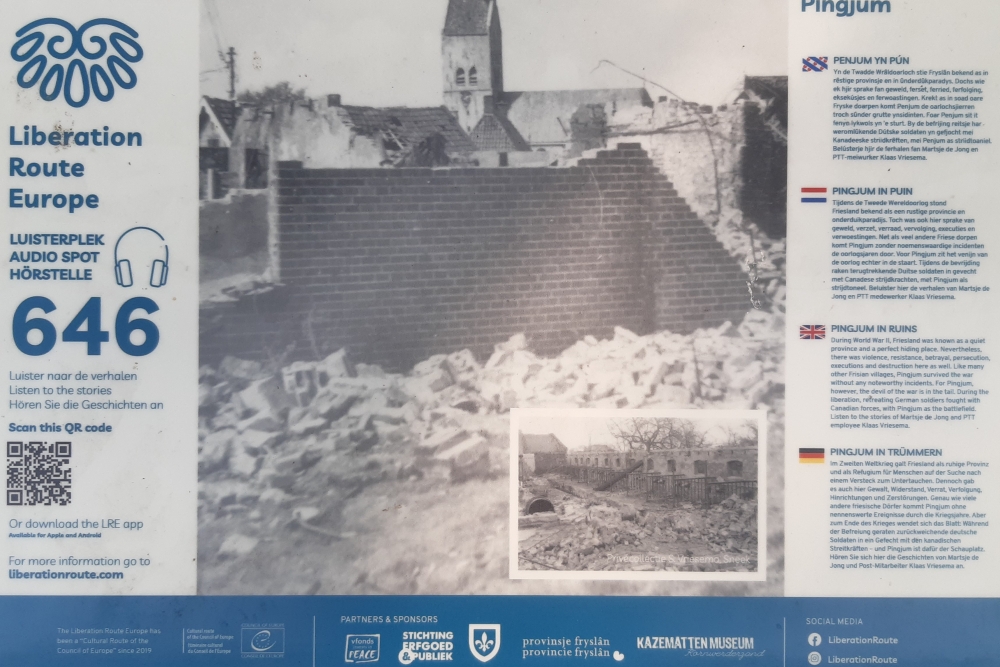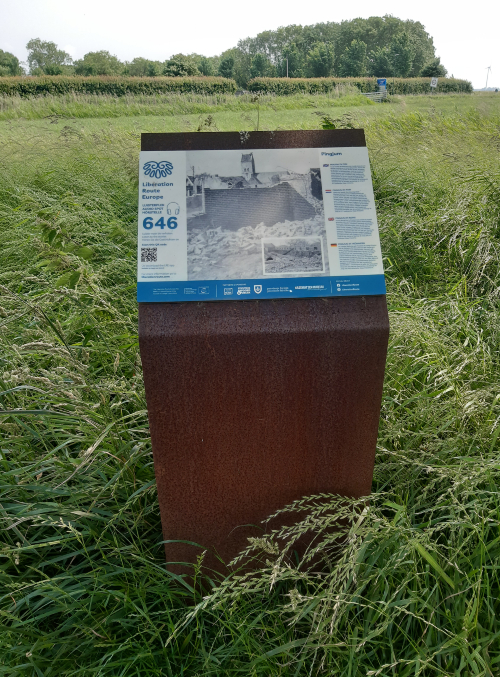Liberation Route Marker 646: Pingjum in Ruins
After several exciting first days of war in May 1940, Pingjum endured the occupation peacefully. In April of 1945, the situation changed dramatically. The retreating German Wehrmacht fought the advancing Canadian army, with Pingjum as its battleground.
By the spring of 1945, it became clear that the German occupier was losing, and many members of the German Wehrmacht, the Dutch Landwacht and NSB members fled to the west. In Friesland, a ‘great migration’ began from the eastern side across the Afsluitdijk on 12 April. Three days later, a group of German snipers settled in Pingjum. They were tasked with defending the retreating German troops on the Afsluitdijk against the advancing Canadians.
Witmarsum was liberated by the Canadians on 16 April. In nearby Pingjum, the German soldiers refused to capitulate. In response, the Canadians opened fire, laying a carpet of mortar shells over Pingjum for 24 hours. Most of the population fled to neighbouring Arum, which had already been liberated.
When the Germans ignored a second ultimatum to surrender, another attack followed, and the village was all but razed to the ground. It was not until 17 April, at around half past nine in the evening, that the first groups of the Queens Own Rifles of Canada arrived, liberating the battered Pingjum.
Liberation Route Europe is a certified Cultural Route of the Council of Europe. With hundreds of sites and stories in nine European countries, the route links the main regions along the advance of the Allied Forces in 1943-1945.
The entire route consists of themed routes that can be travelled by by hiking, walking, cycling and car. These routes pass numerous historical and interesting sites and tell stories from a multitude of perspectives that were important in the final phase of World War II.
Many routes feature listening spots, offering the opportunity to listen to a historical story at a location. In addition, many ‘Vectors of Memory’ have been placed, indicating that the passer-by is on one of the Liberation Routes.
The routes can be found on the Liberation Route Europe website or in the app through which many stories can also be listened to.
Do you have more information about this location? Inform us!
Source
- Text: TracesOfWar & Liberation Route Europe
- Photos: Cor Keuning
Nearby
Museum
Point of interest
Monument
Cemetery
- Commonwealth War Graves Protestant Churchyard Witmarsum - Witmarsum
- Commonwealth War Graves Protestant Churchyard Kimswerd - Kimswerd
- Dutch War Graves Protestant Churchyard - Wons
Remembrance Stone
- Stumbling Stones Rozengracht 15 - Harlingen
- Stumbling Stones Heiligeweg 28a - Harlingen
- Stumbling Stones Heiligeweg 19 - Harlingen
Fortification
- German Bunkers Harlingen - Harlingen
- Stelling Kornwerderzand - Casemate IX - Kornwerderzand
- Radio Bearing Station Löwenzahn I Franeker - Franeker






